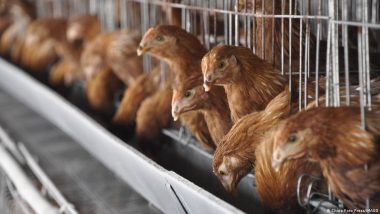E.coli and Salmonella bacteria have been found to share genetic information as a way to develop antibiotic resistance.A study of Escherichia coli and Salmonella enterica samples from 10 commercial chicken farms and slaughterhouses in China has found that the bacteria can evolve genetically to develop antimicrobial resistance — by sharing genetic information, known as mobile genetic elements.
"Bacterial are known to share genetic information using mobile genetic elements. However, the extent to which bacteria do this across species is not fully understood as most research studies focus on a single bacterial species," said Tania Dottorini, a co-author of the study, in an email to DW.
Also Read | Why Big Animals Are Getting Smaller.
The two "species" in this case were the bacteria E. coli and S. enterica. They are commonly found in the food chain, whether it's feed for livestock or food for humans, and can cause severe illness or food poisoning.
For the current study, the researchers collected samples of the two bacteria from the same animals and locations — from chicken feces, carcasses, feathers, feed, soil, wastewater, anal swabs, abattoir environments and drinking water.
They found that the E. coli and S. enterica shared mobile genetic elements specifically linked to antimicrobial resistance (AMR).
"This sharing of AMR-related mobile genetic elements from E. coli and S. enterica has not been identified previously but could be happening on a large scale in similar environments to the farms we studied," said Dottorini.
Why is it important to study antimicrobial resistance?
It's a simple matter of life and death. Antimicrobial resistance — or AMR — is considered a major global public health and development threat.
Bacteria such as E. coli and S. enterica can cause potentially fatal diarrheal disease in humans, especially, in low-to-middle income countries.
The World Health Organization says bacterial AMR caused an estimated 1.27 million global deaths in 2019 (the most recent WHO data), and contributed to a further 4.95 million deaths that same year. The WHO says this was due to the "misuse and overuse" of antimicrobials in humans, animals and plants.
Antimicrobials are drugs and chemicals we use to fight off bacteria. They are often associated exclusively with antibiotics, but they also include antiseptics, disinfectants and antifungal agents.
We have become reliant on a whole range of antimicrobial agents — to treat bacterial infections in humans, but also to prevent infection and promote growth in poultry on industrial farms.
Bacteria have evolved defence mechansisms against drugs, so much so that antibacterials are becoming ineffective in treating many diseases, even ones relatively harmless like uriniary tract infections (UTIs).
"The mobile genetic elements within a bacterial genome play a crucial role in bacterial evolution and have implications for antibiotic resistance," said Filipa Vale, an expert in microbial biology and genetics at the University of Lisbon.
Vale was not involved in the current study, but told DW that the findings from "real-world settings poses a significant threat of transferring AMR to humans and the environment, highlighting the importance of studying MGEs among bacteria."
Researchers use machine learning to analyze AMR data
The researchers used artificial intelligence to pinpoint specific genes and mutations that displayed a strong link to antimicrobial resistance.
"The [machine learning] results revealed that both species had a common subset of features strongly linked to AMR […]," the researchers write in the study paper.
Expanding on the findings, Dottorini told DW: "We found for the first time that many isolates of both E. coli and S. enterica in the real-world setting we studied shared the same MGEs. This could be indicative that these AMR-carrying MGEs are necessary to survive within the host and environment in which they were found."
Dottorini said, however, that the study "only considered two bacterial species. It is likely that similar behavior would be found in other bacterial species occupying this same microbiome environment. Future studies will broaden our research to address this question."
How the findings in China compare to AMR in Europe
The researchers compared their findings with antimicrobial resistant bacteria in similar settings in Europe.
They found there were more types of mobile genetic elements in the samples from China than in samples from comparable European settings.
And those MGEs were "present significantly more frequently."
The differences in the findings, said Dottorini, may be "driven by variations in antibiotic usage and intervention strategies” in the two locations.
"These findings are highly likely to apply to other geographic settings, where farming and antibiotic usage practices are similar to those of China," said Dottorini.
For future research, Dottorini said low-middle income countries, where "intensive farming strategies are being increasingly employed and antimicrobial usage regulation is often less strict than in Europe" would be of particular interest.
Edited by: Fred Schwaller
(The above story first appeared on LatestLY on Jan 19, 2024 09:00 PM IST. For more news and updates on politics, world, sports, entertainment and lifestyle, log on to our website latestly.com).













 Quickly
Quickly





















